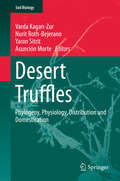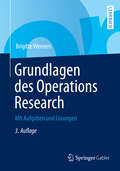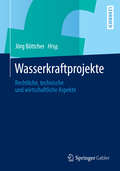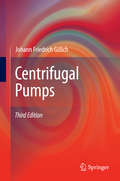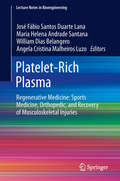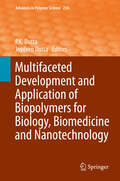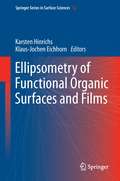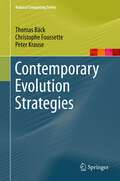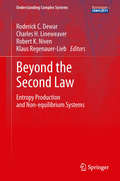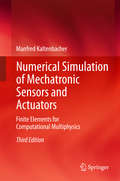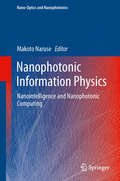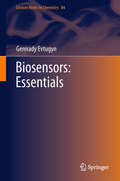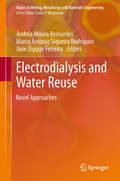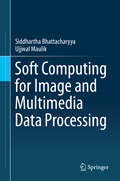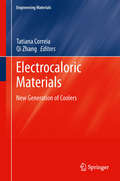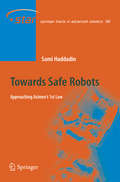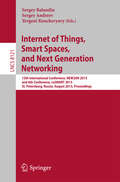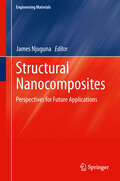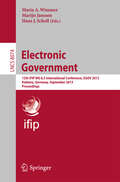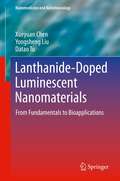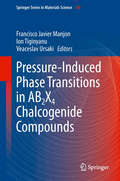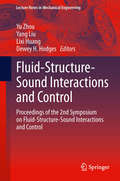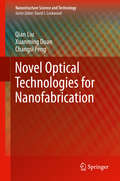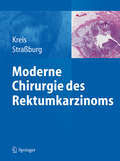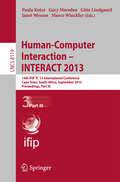- Table View
- List View
Desert Truffles: Phylogeny, Physiology, Distribution and Domestication (Soil Biology #38)
by Varda Kagan-Zur Nurit Roth-Bejerano Yaron Sitrit Asunción MorteDesert truffles are found in every known desert, irrespective of the habitat – cool or hot, loamy or acidic, sandy or heavy soil – the only common condition seems to be a limited supply of water. In contrast to ‘true’ truffles, desert truffles have evolved over time in different families, mainly within the order Pezizales. While in some arid areas, desert truffles have been traditionally used as food, in most regions interest has only recently been increasing, and truffles are now treasured for their nutritional value, as an income source and for research.This volume gives a comprehensive overview of the phylogeny, biology, mycorrhizal association, and distribution of desert truffles, their use, biochemical and medicinal properties, as well as their domestication and cultivation.
Grundlagen des Operations Research: Mit Aufgaben und Lösungen (Springer-Lehrbuch)
by Brigitte WernersDas Buch bietet eine fundierte, anschauliche Einführung in die grundlegenden Modelle und Methoden des Operations Research, insbesondere für Wirtschaftswissenschaftler. Die lineare Optimierung wird einschließlich Dualität und Sensitivitätsanalyse behandelt, vielfältige Beispiele zeigen ihr Potenzial für praktische Anwendungen auf. Weiterhin werden Graphen mit ihren Einsatzmöglichkeiten am Beispiel Logistik und besonders Projektplanung vorgestellt. Mittels Simulation werden Entscheidungen für deterministische und stochastische Systeme unterstützt, demonstriert an Beispielen der Anlagenbelegung, Warteschlangentheorie und Risikoanalyse. Zahlreiche Übungen mit ausführlichen Lösungen fördern anwendungsorientiert die Methodenkompetenz. Durch die Kombination der Vermittlung mathematischer mit wirtschaftswissenschaftlichen Fähigkeiten wird eine hohe Problemlösungskompetenz erreicht. Das Buch richtet sich besonders an Studierende der Wirtschaftswissenschaft, die eine einführende Vorlesung zu Operations Research besuchen.
Wasserkraftprojekte: Rechtliche, technische und wirtschaftliche Aspekte
by Jörg BöttcherDas Buch richtet sich an Studierende und Lehrende im Bereich Umweltökonomie und Erneuerbare Energien, aber auch an Praktiker, die sich mit den rechtlichen, technischen und wirtschaftlichen Fragestellungen im Rahmen von Wasserkraftprojekten beschäftigen. Dieses Buch ist aus der Wahrnehmung entstanden, dass es eines gemeinsamen Verständnisses und konzertierten Vorgehens von Vertretern aus Recht, Technik und Wirtschaft bedarf, um Wasserkraftprojekte umzusetzen. Daher wird in dieser Publikation der Weg beschritten, verschiedene Experten aus den genannten Bereichen zu Wort kommen zu lassen, so dass in der Gesamtschau vermittelt wird, welche Aspekte bei der Realisierung von Wasserkraftprojekten zu beachten sind. Der Anspruch des Buches ist es aufzuzeigen, welche technischen und rechtlichen Voraussetzungen zum jetzigen Zeitpunkt erfüllt sein müssen, um ein Wasserkraftprojekt über die Finanzierungsmethode einer Projektfinanzierung zu realisieren. Und weiter soll durch den Interdisziplinären Ansatz erreicht werden, dass der Leser für die Anforderungen der verschiedenen Teilbereiche sensibilisiert wird.
Centrifugal Pumps
by Johann Friedrich GülichThis book gives an unparalleled, up-to-date, in-depth treatment of all kinds of flow phenomena encountered in centrifugal pumps including the complex interactions of fluid flow with vibrations and wear of materials. The scope includes all aspects of hydraulic design, 3D-flow phenomena and partload operation, cavitation, numerical flow calculations, hydraulic forces, pressure pulsations, noise, pump vibrations (notably bearing housing vibration diagnostics and remedies), pipe vibrations, pump characteristics and pump operation, design of intake structures, the effects of highly viscous flows, pumping of gas-liquid mixtures, hydraulic transport of solids, fatigue damage to impellers or diffusers, material selection under the aspects of fatigue, corrosion, erosion-corrosion or hydro-abrasive wear, pump selection, and hydraulic quality criteria. As a novelty, the 3rd ed. brings a fully analytical design method for radial impellers, which eliminates the arbitrary choices inherent to former design procedures. The discussions of vibrations, noise, unsteady flow phenomena, stability, hydraulic excitation forces and cavitation have been significantly enhanced. To ease the use of the information, the methods and procedures for the various calculations and failure diagnostics discussed in the text are gathered in about 150 pages of tables which may be considered as almost unique in the open literature. The text focuses on practical application in the industry and is free of mathematical or theoretical ballast. In order to find viable solutions in practice, the physical mechanisms involved should be thoroughly understood. The book is focused on fostering this understanding which will benefit the pump engineer in industry as well as academia and students.
Platelet-Rich Plasma: Regenerative Medicine: Sports Medicine, Orthopedic, and Recovery of Musculoskeletal Injuries (Lecture Notes in Bioengineering)
by José Fábio Santos Duarte Lana Maria Helena Andrade Santana William Dias Belangero Angela Cristina Malheiros LuzoPlatelet-Rich Plasma (PRP) has gained tremendous popularity in recent years as a treatment option for specialties including Orthopedics, Dentistry, Sports Medicine, Otorhinolaryngology, Neurosurgery, Ophthalmology, Urology, Vascular, Cardiothoracic and Maxillofacial Surgery, and Veterinarian Medicine. Nowadays, PRP and Stem Cell Science have added an exciting dimension to tissue repair. This book begins by giving the reader a broad overview of current progress as well as a discussion of the technical aspects of preparation and therapeutic use of autologous PRP. It is followed by a review of platelet structure, function and major growth factors in PRP (PDGF and TGFβ).The third chapter outlines the basic principles of biochemical cellular metabolism that increases the efficacy of PRP. Analogous to the preparation of soil for a garden, restoring cellular health should be the first consideration in Regenerative Medicine. Standardization of PRP preparation to clinical use still remains a challenging prospect. In this sense, a feasible strategy for studying PRP preparation is illustrated, which also allows to modulate and tailor the quality of PRP for further clinical applications. The science behind PRP and stem cells, on tissue regeneration, cell proliferation and mesenchyme stem-cells are emphasized and reviewed. Various specific uses of PRP are described with detailed illustrations of various personal experiences mainly in orthopedic injuries, ligament and tendon repair, degenerative diseases, sports medicine, chronic wound healing as well as rehabilitation aspects in tendinopathy. Expertly written by leading scientists in the field, this book provides for beginners and experienced readers scientific fundamentals, the state of art of PRP, specific uses and personal experiences with a practical approach and reference for current trends in use. Finally, this book paves the way for future developments.
Multifaceted Development and Application of Biopolymers for Biology, Biomedicine and Nanotechnology (Advances in Polymer Science #254)
by P. K. Dutta and Joydeep DuttaNanoparticles for Gene Delivery into Stem Cells and Embryos, by Pallavi Pushp, Rajdeep Kaur, Hoon Taek Lee, Mukesh Kumar Gupta. Engineering of Polysaccharides via Nanotechnology, by Joydeep Dutta. Hydroxyapatite-Packed Chitosan-PMMA Nanocomposite: A Promising Material for Construction of Synthetic Bone, by Arundhati Bhowmick, Subhash Banerjee, Ratnesh Kumar, Patit Paban Kundu. Biodegradable Polymers for Potential Delivery Systems for Therapeutics, by Sanjeev K. Pandey, Chandana Haldar, Dinesh K. Patel, Pralay Maiti. Phytomedicine-Loaded Polymeric Nanomedicines: Potential Cancer Therapeutics, by S. Maya, M. Sabitha, Shantikumar V. Nair, R. Jayakumar. Proteins and Carbohydrates as Polymeric Nanodrug Delivery Systems: Formulation, Properties and Toxicological Evaluation, by Dhanya Narayanan, J. Gopikrishna, Shantikumar V. Nair, Deepthy Menon. Biopolymeric Micro and Nanoparticles: Preparation, Characterization and Industrial Applications, by Anil Kumar Anal, Alisha Tuladhar. Applications of Glyconanoparticles as “Sweet” Glycobiological Therapeutics and Diagnostics, by Naresh Kottari, Yoann M. Chabre, Rishi Sharma, René Roy.
Ellipsometry of Functional Organic Surfaces and Films (Springer Series in Surface Sciences #52)
by Karsten Hinrichs Klaus-Jochen EichhornEllipsometry is the method of choice to determine the properties of surfaces and thin films. It provides comprehensive and sensitive characterization in contactless and non-invasive measurements. This book gives a state-of-the-art survey of ellipsometric investigations of organic films and surfaces, from laboratory to synchrotron applications, with a special focus on in-situ use in processing environments and at solid-liquid interfaces. In conjunction with the development of functional organic, meta- and hybrid materials for new optical, electronic, sensing and biotechnological devices and fabrication advances, the ellipsometric analysis of their optical and material properties has progressed rapidly in the recent years.
Contemporary Evolution Strategies (Natural Computing Series)
by Thomas Bäck Christophe Foussette Peter KrauseThis book surveys key algorithm developments between 1990 and 2012, with brief descriptions, a unified pseudocode for each algorithm and downloadable program code. Provides a taxonomy to clarify similarities and differences as well as historical relationships.
Beyond the Second Law: Entropy Production and Non-equilibrium Systems (Understanding Complex Systems)
by Roderick C. Dewar Charles H. Lineweaver Robert K. Niven Klaus Regenauer-LiebThe Second Law, a cornerstone of thermodynamics, governs the average direction of dissipative, non-equilibrium processes. But it says nothing about their actual rates or the probability of fluctuations about the average. This interdisciplinary book, written and peer-reviewed by international experts, presents recent advances in the search for new non-equilibrium principles beyond the Second Law, and their applications to a wide range of systems across physics, chemistry and biology. Beyond The Second Law brings together traditionally isolated areas of non-equilibrium research and highlights potentially fruitful connections between them, with entropy production playing the unifying role. Key theoretical concepts include the Maximum Entropy Production principle, the Fluctuation Theorem, and the Maximum Entropy method of statistical inference. Applications of these principles are illustrated in such diverse fields as climatology, cosmology, crystal growth morphology, Earth system science, environmental physics, evolutionary biology and technology, fluid turbulence, microbial biogeochemistry, plasma physics, and radiative transport, using a wide variety of analytical and experimental techniques. Beyond The Second Law will appeal to students and researchers wishing to gain an understanding of entropy production and its central place in the science of non-equilibrium systems – both in detail and in terms of the bigger picture.
Numerical Simulation of Mechatronic Sensors and Actuators: Finite Elements for Computational Multiphysics
by Manfred KaltenbacherLike the previous editions also the third edition of this book combines the detailed physical modeling of mechatronic systems and their precise numerical simulation using the Finite Element (FE) method. Thereby, the basic chapter concerning the Finite Element (FE) method is enhanced, provides now also a description of higher order finite elements (both for nodal and edge finite elements) and a detailed discussion of non-conforming mesh techniques. The author enhances and improves many discussions on principles and methods. In particular, more emphasis is put on the description of single fields by adding the flow field. Corresponding to these field, the book is augmented with the new chapter about coupled flow-structural mechanical systems. Thereby, the discussion of computational aeroacoustics is extended towards perturbation approaches, which allows a decomposition of flow and acoustic quantities within the flow region. Last but not least, applications are updated and restructured so that the book meets modern demands.
Nanophotonic Information Physics: Nanointelligence and Nanophotonic Computing (Nano-Optics and Nanophotonics)
by Makoto NaruseThis book provides a new direction in the field of nano-optics and nanophotonics from information and computing-related sciences and technology. Entitled by "Information Physics and Computing in NanosScale Photonics and Materials”, IPCN in short, the book aims to bring together recent progresses in the intersection of nano-scale photonics, information, and enabling technologies. The topic will include (1) an overview of information physics in nanophotonics, (2) DNA self-assembled nanophotonic systems, (3) Functional molecular sensing, (4) Smart fold computing, an architecture for nanophotonics, (5) semiconductor nanowire and its photonic applications, (6) single photoelectron manipulation in imaging sensors, (6) hierarchical nanophotonic systems, (8) photonic neuromorphic computing, and (9) SAT solver and decision making based on nanophotonics.
Biosensors: Essentials (Lecture Notes in Chemistry #84)
by Gennady EvtugynToday, biosensors are broadly applied in research, clinical diagnosis and monitoring, as well as in pharmaceutical, environmental or food analysis. In this work, the author presents the essentials that advanced students and researchers need to know in order to make full use of this technology. This includes a description of biochemical recognitionelements, such as enzymes, antibodies, aptamers or even whole cells. Various signal transducers such as electrochemical and optical transducers, luminescence devices and advanced techniques such as quartz crystal microbalances and MEMS systems are covered as well. Current applications are introduced through various case studies, rounded out by a forward-looking chapter on the prospects for biosensor development offered by nanotechnology, lab-on-a-chip, and biomimetic systems.
Electrodialysis and Water Reuse: Novel Approaches (Topics in Mining, Metallurgy and Materials Engineering)
by Andréa Moura Bernardes Marco Antônio Siqueira Rodrigues Jane Zoppas FerreiraThis book presents novel techniques to evaluate electrodialysis processes, to synthesize ionic membranes and to characterize their properties. It shows the potential use of membrane process to the treatment of effluents generated in many industrial sectors such as refineries, leather industries, mining and electroplating processes. The book is based on the results obtained by the author's research group during the past decade. It is useful for students, researchers and engineers interested in membrane technologies for water reuse.
Soft Computing for Image and Multimedia Data Processing
by Siddhartha Bhattacharyya Ujjwal MaulikProper analysis of image and multimedia data requires efficient extraction and segmentation techniques. Among the many computational intelligence approaches, the soft computing paradigm is best equipped with several tools and techniques that incorporate intelligent concepts and principles. This book is dedicated to object extraction, image segmentation, and edge detection using soft computing techniques with extensive real-life application to image and multimedia data. The authors start with a comprehensive tutorial on the basics of brain structure and learning, and then the key soft computing techniques, including evolutionary computation, neural networks, fuzzy sets and fuzzy logic, and rough sets. They then present seven chapters that detail the application of representative techniques to complex image processing tasks such as image recognition, lighting control, target tracking, object extraction, and edge detection. These chapters follow a structured approach with detailed explanations of the problems, solutions, results, and conclusions. This is both a standalone textbook for graduates in computer science, electrical engineering, system science, and information technology, and a reference for researchers and engineers engaged with pattern recognition, image processing, and soft computing.
Electrocaloric Materials: New Generation of Coolers (Engineering Materials #34)
by Tatiana Correia Qi ZhangSince the 1997 Kyoto protocol of reduction of greenhouse gas emissions, the development of novel refrigerators has been a priority within the scientific community. Although magnetocaloric materials are promising candidates, they still need a large magnetic field to induce a giant ΔT as well as powerful and costly magnets. However, in electrocaloric materials (ECMs) a temperature change may be achieved by applying or removing an electric field. Since a giant electrocaloric effect on ferroelectric thin films was reported in Science in 2006, researchers have been inspired to explore such effect in different ferroelectric thin films. This book reviews electrocaloric effects observed in bulk materials as well as recent promising advances in thin films, with special emphasis on the ferroelectric, antiferroelectric and relaxor nature of ECMs. It reports a number of considerations about the future of ECMs as a means of achieving an efficient, ecologically sustainable and low cost refrigerator.
Towards Safe Robots: Approaching Asimov’s 1st Law (Springer Tracts in Advanced Robotics #90)
by Sami HaddadinThe vision of seamless human-robot interaction in our everyday life that allows for tight cooperation between human and robot has not become reality yet. However, the recent increase in technology maturity finally made it possible to realize systems of high integration, advanced sensorial capabilities and enhanced power to cross this barrier and merge living spaces of humans and robot workspaces to at least a certain extent. Together with the increasing industrial effort to realize first commercial service robotics products this makes it necessary to properly address one of the most fundamental questions of Human-Robot Interaction: How to ensure safety in human-robot coexistence? In this authoritative monograph, the essential question about the necessary requirements for a safe robot is addressed in depth and from various perspectives. The approach taken in this book focuses on the biomechanical level of injury assessment, addresses the physical evaluation of robot-human impacts, and isolates the major factors that cause human injuries. This assessment is the basis for the design and exploration of various measures to improve safety in human-robot interaction. They range from control schemes for collision detection, reflex reaction, and avoidance to the investigation of novel joint designs that equip robots with fundamentally new capabilities. By the depth of its analysis and exceptionally salient experimental work, this monograph offers one of the most comprehensive treatments of the safety challenge in the field.
Internet of Things, Smart Spaces, and Next Generation Networking: 13th International Conference, NEW2AN 2013, and 6th Conference, ruSMART 2013, St. Petersburg, Russia, August 28-30, 2013. Proceedings (Lecture Notes in Computer Science #8121)
by Sergey Balandin Sergey Andreev Yevgeni KoucheryavyThis book constitutes the joint refereed proceedings of the 13 International Conference on Next Generation Teletraffic and Wired/Wireless Advanced Networking, NEW2AN, and the 6th Conference on Internet of Things and Smart Spaces, ruSMART 2013, held in St. Petersburg, Russia, in August 2013. The total of 38 papers was carefully reviewed and selected for inclusion in this book. The 14 papers selected from ruSMART are organized in topical sections named: internet on things, smart spaces technologies; and smart systems. The 24 papers from NEW2AN deal with the following topics: performance and efficiency analysis, network and transport layer issues; cognitive radio networks; sensor and mesh networks; upper layer protocols and applications; ad-hoc, cellular and satellite networks.
Structural Nanocomposites: Perspectives for Future Applications (Engineering Materials)
by James NjugunaAdvancements in the nanotechnology industry promise to offer improvements in capabilities across a spectrum of applications. This is of immense strategic importance to the high performance sector which has historically leveraged technological advances. The use of polymer nanocomposites in structures have several predictable impacts on structural design and applications, primarily by providing a safer, faster, and eventually cheaper transportation in the future. This books comprises reviews on the state-of-the-art, new research results, perspectives of future developments, and innovative applications relevant to structural materials, engineering structures, nanocomposites, modelling and simulations, and their related application areas.
Electronic Government: 12th IFIP WG 8.5 International Conference, EGOV 2013, Koblenz, Germany, September 16-19, 2013, Proceedings (Lecture Notes in Computer Science #8074)
by Maria A. Wimmer Marijn Janssen Hans Jochen SchollThis book constitutes the refereed proceedings of the 12th IFIP WG 8.5 International Conference on Electronic Government, EGOV 2013, held in Koblenz, Germany, in September 2013. The 27 revised full papers presented were carefully reviewed and selected for inclusion in this volume. The papers have been organized in the following topical sections: research foundations; open government data and transparency; service design and improvement; adoption and service evaluation; and social media and social network analysis.
Lanthanide-Doped Luminescent Nanomaterials: From Fundamentals to Bioapplications (Nanomedicine and Nanotoxicology)
by Xueyuan Chen Yongsheng Liu Datao TuLanthanide-Doped Luminescent Nanomaterials reviews the latest advances in the development of lanthanide-doped luminescent inorganic nanoparticles for potential bioapplications. This book covers the chemical and physical fundamentals of these nanoparticles, such as the controlled synthesis methodology, surface modification chemistry, optical physics, and their promising applications in diverse bioassays, with an emphasis on heterogeneous and homogeneous in-vitro biodetection of tumor biomarkers. This book is intended for those readers who are interested in systematically understanding the materials design strategy, optical behavior of lanthanide ions, and practical bioapplications of lanthanide nanoparticles. It primarily focuses on the interdisciplinary frontiers in chemistry, physics and biological aspects of luminescent nanomaterials. All chapters were written by scientists active in this field and for a broad audience, providing both beginners and advanced researchers with comprehensive information on the subject.Xueyuan Chen is a Professor at Fujian Institute of Research on the Structure of Matter (FJIRSM), Chinese Academy of Sciences. Yongsheng Liu is a Research Associate Professor at FJIRSM, Chinese Academy of Sciences.Datao Tu is a Research Assistant Professor at FJIRSM, Chinese Academy of Sciences.
Pressure-Induced Phase Transitions in AB2X4 Chalcogenide Compounds (Springer Series in Materials Science #189)
by Francisco Javier Manjon Ion Tiginyanu Veaceslav UrsakiThis book on pressure-induced phase transitions in AB2X4 chalcogenide compounds deals with one important AmBnXp material. The interest in these materials is caused by their properties. The results are discussed for three main groups of structural families: cubic-spinel structures, defective tetragonal structures, and other structures like layered and wurtzite-type modifications. A systematic analysis of the behavior of cubic (spinel), tetragonal (defect chalcopyrites and stannites) and other crystal modifications of AB2X4 compounds under hydrostatic pressure is performed. The behavior of AIIAl2S4, AIIGa2S4, AIIAl2Se4 and AIIGa2Se4 compounds with defective tetragonal structures, compounds with layered and wurtzite structures under hydrostatic pressure and the pressure dependence of the band gap, lattice parameters, interatomic distances, vibrational modes and pressure-induced phase transitions is discussed. Many of these compounds, except oxide spinels, undergo a pressure-induced phase transition towards the rocksalt-type structure. The phase transition is preceded by disorder in the cation sublattice. The dependence of the transition pressure to the rocksalt-type structure as a function of the compound ionicity and the size criterion is analyzed. At high pressures, all ordered-vacancy compounds are found to exhibit a band anticrossing between several conduction bands that leads to a strong decrease of its pressure coefficient and consequently to a strong non-linear pressure dependence of the direct bandgap energy. Theoretical studies of phase transitions in several ordered-vacancy compounds reveal that the existence of ordered vacancies alter the cation-anion bond distances and their compressibilities. The book is written for students, Ph D. students and specialists in materials science, phase transitions and new materials.
Fluid-Structure-Sound Interactions and Control: Proceedings of the 2nd Symposium on Fluid-Structure-Sound Interactions and Control (Lecture Notes in Mechanical Engineering)
by Yu Zhou Yang Liu Lixi Huang Dewey H. HodgesWith rapid economic and industrial development in China, India and elsewhere, fluid-related structural vibration and noise problems are widely encountered in many fields, just as they are in the more developed parts of the world, causing increasingly grievous concerns. Turbulence clearly has a significant impact on many such problems. On the other hand, new opportunities are emerging with the advent of various new technologies, such as signal processing, flow visualization and diagnostics, new functional materials, sensors and actuators, etc. These have revitalized interdisciplinary research activities, and it is in this context that the 2nd symposium on fluid-structure-sound interactions and control (FSSIC) was organized. Held in Hong Kong (May 20-21, 2013) and Macau (May 22-23, 2013), the meeting brought together scientists and engineers working in all related branches from both East and West and provided them with a forum to exchange and share the latest progress, ideas and advances and to chart the frontiers of FSSIC.The Proceedings of the 2nd Symposium on Fluid-Structure-Sound Interactions and Control largely focuses on advances in the theory, experimental research and numerical simulations of turbulence in the contexts of flow-induced vibration, noise and their control. This includes several practical areas for interaction, such as the aerodynamics of road and space vehicles, marine and civil engineering, nuclear reactors and biomedical science etc. One of the particular features of these proceedings is that it integrates acoustics with the study of flow-induced vibration, which is not a common practice but is scientifically very helpful in understanding, simulating and controlling vibration. This offers a broader view of the discipline from which readers will benefit greatly.These proceedings are intended for academics, research scientists, design engineers and graduate students in engineering fluid dynamics, acoustics, fluid and aerodynamics, vibration, dynamical systems and control etc.Yu Zhou is a professor in Institute for Turbulence-Noise-Vibration Interaction and Control at Harbin Institute of Technology. Yang Liu is an associate professor at The Hong Kong Polytechnic University. Lixi Huang, associate professor, works at the University of Hong Kong. Professor Dewey H. Hodges works at the School of Aerospace Engineering, Georgia Institute of Technology.
Novel Optical Technologies for Nanofabrication (Nanostructure Science and Technology)
by Qian Liu Xuanming Duan Changsi PengNovel Optical Technologies for Nanofabrication describes recent advances made in micro/nanofabrication with super-resolution laser technologies, which are based on the latest research findings in the authors’ groups. It focuses on new techniques and methods as well as applications and development trends in laser nanofabrication, including super-resolution laser direct writing, surface structures composed of laser path-guided wrinkle, three-dimensional laser nanofabrication based on two-photon absorption, and nanofabrication by laser interference and surface plasmon polaritons. This book serves as a reference for academic researchers, engineers, technical professionals and graduate students in the fields of micro/nanotechnology, thin film materials, super-resolution optics and laser techniques. Qian Liu is a Professor at Laboratory for Nanodevice, National Center for Nanoscience and Technology, China. Xuanming Duan is a Professor at the Key Laboratory of Functional Crystals and Laser Technology, Technical Institute of Physics and Chemistry, Chinese Academy of Sciences, China Changsi Peng is a Professor at the Institute of Information Optical Engineering, Soochow University, China.
Moderne Chirurgie des Rektumkarzinoms
by Martin E. Kreis Joachim StraßburgDie Chirurgie des Rektumkarzinoms ist in Bewegung; zahlreiche Entwicklungen tragen zu spezifischer Behandlung und besseren Therapieergebnissen bei: verfeinerte Diagnostik durch neue Interpretation bildgebender und histopathologischer Befunde; stadienspezifische Therapiestrategien; neue operative Techniken und ihre Anwendung; zeitgemäße perioperative Behandlung.Alle modernen Entwicklungen der operativen Therapie des Rektumkarzinoms und ihres Umfeldes werden von renommierten Autoren in 21 fundierten, praxisbezogenen Kapiteln in Wort und Bild beschrieben, auch die wichtigsten Studien und Projekte sind berücksichtigt. So entsteht ein umfassender Überblick über die Rektumchirurgie von heute aus erster Hand.
Human-Computer Interaction -- INTERACT 2013: 14th IFIP TC 13 International Conference, Cape Town, South Africa, September 2-6, 2013, Proceedings, Part III (Lecture Notes in Computer Science #8119)
by Janet Wesson Marco Winckler Paula Kotzé Gary Marsden Gitte LindgaardThe four-volume set LNCS 8117-8120 constitutes the refereed proceedings of the 14th IFIP TC13 International Conference on Human-Computer Interaction, INTERACT 2013, held in Cape Town, South Africa, in September 2013. The 53 papers included in the third volume are organized in topical sections on mobile usage and techniques, mobile UX and privacy concerns, model-based user interface design, multimodal user interface design, multimodality, cross-platform studies, narratives in design, navigation aids, novel user interfaces, passwords: e-authentication, physical ergonomics, road safety, seniors and usability, social behaviour, collaboration and presence, social collaborative interaction, social media, and software development.
